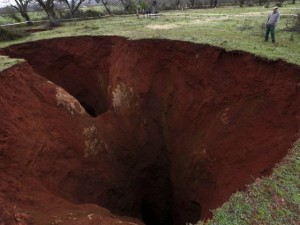
A resort in Clermont, Florida collapsed into a sinkhole, Monday, August 12, 2013. Photo posted to Twitter by RedHuber.
A section of a resort building in Clermont, Florida collapsed into a sinkhole Monday morning, August 12, 2013. I used to go to Clermont all the time as a kid. I was raised in Jacksonville, and my aunt lives in Clermont.
I remember there were lakes on every block, and the water table was just inches from the surface.
Sinkholes?
Well, of course. When the water is at ground level, many factors can cause the shifting of the surface – both above and below ground level.
Heavy rains, extended rainfall, a rise in sea level, or the weakening of the substrate due to construction and concrete can cause ground movement. Water will channel under the surface as sea levels rise or flooding occurs, and this saturates the soil – soil that is already filled with water.
Any shift or ground movement (like a shift in rotation or earthquakes in the Caribbean) will move into the cracks and crannies under the surface. And, there you have it – a sinkhole results.
Not A Surprise
The resort underwent geological testing when it was built about 15 years ago, which showed that the ground under the building was stable. Inspectors said that there were no signs before Sunday’s collapse that a sinkhole was developing.
No one took into consideration present-day Earth changes, and as the Earth continues to warm at the same time ice melts rapidly at the North and South Poles, sea levels are warming and rising. THIS seeps into the porous soil of saturated Florida, and sinkholes are NOT a surprise.
Well, not to me anyway … I better call my aunt.

